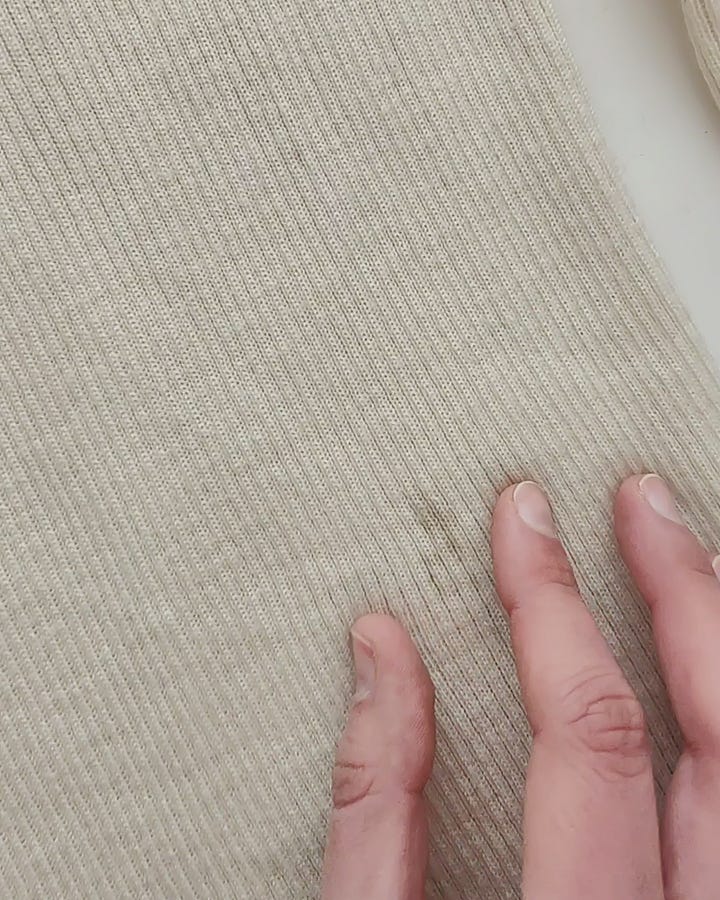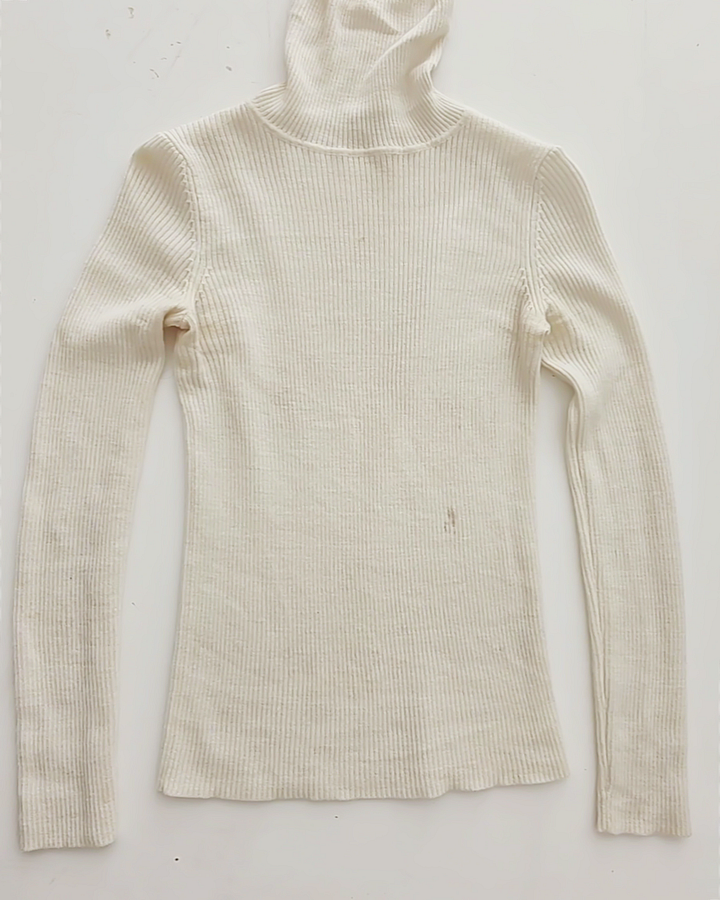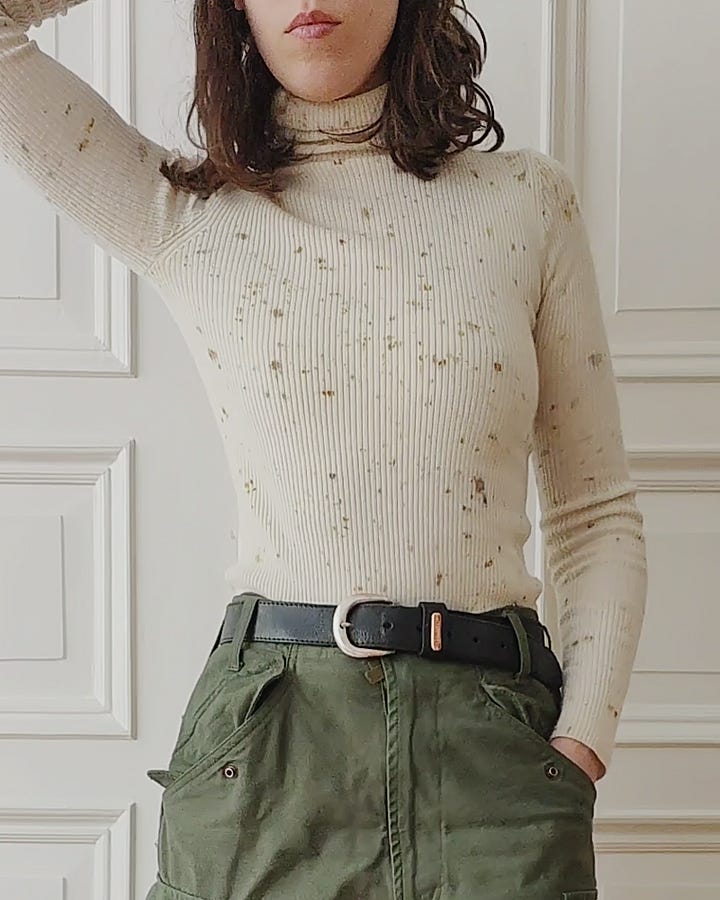Healing the wardrobe with plant dyes
tutorial for re-loving your old clothes with bundle dyeing
Kaliko Journal is a free newsletter about natural dyeing, textiles, art practice, and life by Ania Grzeszek. This publication is divided into two sections: ”Plant Dyeing” and “Studio Practice”. You can manage your subscription by clicking “Unsubscribe” at the bottom of the email and opting IN and OUT of the sections that interest you. This is also where you can pledge your financial support for this publication, which would help me continue to sustain it.
Feel free to share parts of this letter wherever and with whomever you’d like, remembering to tag me. If you want to support my work, subscribe to this publication and/or purchase my handmade products. Take care of yourself wherever you are.
Maybe you’ve heard, maybe you haven’t heard, I am repeating it anyway because I’m excited to share: I’m launching CLOTHES CLINIC with its first event in June.
I stopped buying new clothes in 2015 when I learned about the social costs of the fashion industry (not to mention the environmental costs on top of that, but its people’s suffering that tipped the scale for me). I still make exceptions from time to time when I need new socks or underwear, though I purposefully didn’t get any fast-fashion items for the past 8 years. I am not saying it from a higher moral ground, far from it. It is meant as an inspiration, because I believe anyone can do it, and should do it. It’s better, cheaper and looks cooler. The only “less” — it’s less easy.
And because I acknowledge it’s less easy, I want to help those who care to re-love their old clothes. If there’s one thing I am good at it’s natural dyeing, so I am opening my studio doors and inviting you to upcycle your clothes (or curtains! or tote bags! or shoes! or napkins!) under my guidance. If you’re not in Berlin, you can participate remotely and ship your pieces to me. I will dye them and send them full of fresh energy back to you. And if you’d rather do it all by yourself at home, here’s how I upcycled my beloved second-hand turtleneck this week:
Requirements for plant dyeing
Before you start, here are some things to keep in mind:
plant dyes only work on natural fibers: cotton, linen, wool, silk, etc. (no acetate, polyamide, acrylic, nylon, polyester, etc.). please check the fabric to avoid disappointments.
plant dyes are translucent, whatever color is used as a “base”, it’s going to be visible after dyeing. depending on how the pieces were dyed previously, some of the pieces might take up the dye poorly, so the safest option is white or beige. You can message me if you’re not sure!
clothes have to be washed before dyeing; for cotton and linen wash with baking soda (natron) without bleach or softeners. for wool and silk rinse with wool soap.
the durability of natural color is a spectrum and depends on the fixatives and plants used. Plant dyed textiles can only be washed by hand using ecological washing soap, and should be stored away from the direct sunlight
Preparing the fabric
Two ways to go here: either you use a natural pre-fixative and get more durable colors or work without it and re-do the dyeing every once in a while. I suggest always working with a pre-fixative for plant-based fibers like cotton or linen. Wool and silk generally take up plant colors better, so if you don’t mind re-dyeing the fibers when the dyes fade, it’s an easy option.
For my wool turtleneck (like for most of my projects) I worked with aluminium formate. This is my favorite pre-fixative. It’s an aluminium salt which is applied cold by soaking the fibers in its solution. I usually let the fibers sit in the solution for at least 24h but for this one I wanted it to be quick and easy so I tried just one hour and it seemed to work OK. (I only experiment like that on personal items, things for sale have to hold up to my standards.) When handling aluminium or other metal salts, always wear gloves. More info on pre-fixatives (mordants) in this blog post or in-depth in my ebook.
Choosing the dyes
Plant color durability is a spectrum. I never get tired of repeating that because this is one of the main features of natural dyes I want you to remember about. If your plant color is not durable in itself, no fixative will change it. I find it to actually be a super cool feature—especially in bundle dyeing. As color spots change at a different pace, your garments seems to live its own secret life. Choosing dyes to work with is important part of the design process. If you’re not sure what to got for, you can always ask me for help.
Sometimes less is more (and sometimes more is more, though), and a little goes a long way. I loved that the turtleneck was cream-white and I didn't want to change it so my plant selection was purposefully scarce. I worked only with one dye—dried rose—and used minimal amounts of plant matter. My idea was to get modest beige splatters that would mask existing (and future!) stains.


Dyeing process
After soaking the piece in aluminium formate, I scattered small amount of rose petals over the front of the turtleneck. I then rolled it up from the bottom to the top. I didn't have to add any more plant material to the back, as the petals were now sandwiched between both sides. I scattered some more dye over the exposed parts after bundling and wrapped my package into a piece of cloth to hold everything tight.



To set the dye it should be exposed to heat. You could simmer your piece or steam it. The difference is that steaming makes clearer prints, while simmering makes the dye dissolve in water and partially transfer to the background, too. I steamed my turtleneck for 1 hour and because it’s wool, I let it cool down overnight, before opening and rinsing it thoroughly in cold water.



New (to me) bundle-dyed turtleneck
What I specifically love about the result is that despite using just one single dye, the pattern is multi-colored. Rose petals made beautiful speckles, from brown to beige, green, yellow, and even purple and blue. They are all very muted, though, and work beautifully against my cream-white base. The stains I wanted to cover are not to be spotted anymore. I expect the speckles to all become more beige overtime (rose is not specifically a great dye source), and I know I will love it too. Because this garment is made of wool, the speckles will most probably never fade, but if they would, I know how to refresh them.


Here’s the video of the process with great background music:
CLOTHES CLINIC
If you liked that, I would love to welcome you to the first edition on June 10th!
CLOTHES CLINIC is open to Berliners, as well as anyone who wants to send their clothes for upcycling. Because I believe in accessibility, this event is donation-based, and those who can’t afford to pay the full price are welcome to pay whatever they can. Suggested price is 35€ per piece of regular size (like a top or a scarf) and that includes materials, tools, and of course my guidance. Detailed info here.
I will be waiting for you in my studio in Berlin-Wedding (Exerzierstraße 8, 13357) on Saturday June 10th, from 11am to 4pm. Stop by anytime you can, the process takes around 1,5h, and there’s a cafe around the corner, there are Ufer Studios to visit and there’s Panke River to chill out at while you wait.
If you’re not in Berlin, you can send me your pieces and I will dye them for you. Give me a color theme or let me do my magic.
I’m so excited for us to work on this dream project together!




